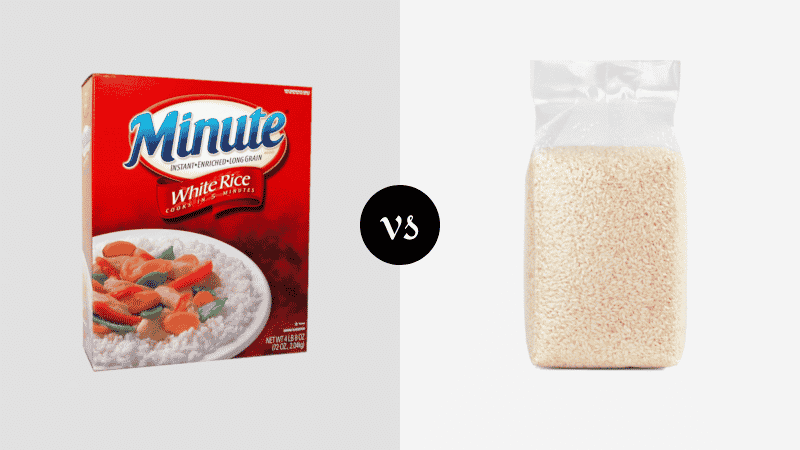
Rice is a popular choice of food for many people around the world. Many different varieties are available, and each is extremely healthy and easy to cook.
Rice can be cooked using several different techniques and is included in a range of different recipes. There are many different types of rice across assorted sizes, all with different timing and appropriate means of cooking.
We’ll be taking you through a comparison of minute rice vs. regular rice. These two varieties are vastly different, ranging from how they’re grown to the distinct cooking periods called for.
Always know exactly which variety suits your next meal best by going through our comprehensive breakdown of the defining characteristics of both.
Minute Rice Vs. Regular Rice Comparison
| Minute Rice | Regular Rice | |
| Definition | Precooked Dehydrated White Rice | Raw Regular Milled Rice – Rice Hulled Of Husk, Bran & Germ And Then Polished |
| Names | Minute Rice, Instant Rice, Precooked Parboiled Rice | Milled White Rice, White Rice, Long-Grain White Rice, Short-Grain White Rice, Medium-Grain White Rice |
| Processing | Blanched, Steamed And Rinsed Rice That’s Dried To The Point Of Dehydration In Huge Ovens Until Moisture Content Reaches 12% Or Less | Milled By Means Of Pounding And Processing Through A Sequence Of Mechanical Cleaner, Dehusker, Winnower And Polisher Before Grading And Finally Packaging |
| Rice To Water Ratio | 1-To-1 | 1-To-2 |
| Nutrients | Same Nutrient Profile As Regular White Rice Just Lower Concentration Of Nutrients Due To Dehydration | 4.6 Grams Protein, 0.58 Grams Of Fat, 41.17 Grams Carbohydrates, 194.34 Kilocalories, 0.17 Grams Sugar, 1.42 Grams Of Fiber, 30 Milligrams Calcium, 2.86 Grams Iron, 14.22 Grams Magnesium,86.9 Milligrams Phosphorus, 88.48 Grams Potassium, 3.16 Grams Sodium |
| Flavor | Less Inherent Flavor, Added Salt & Sugar | Packed With Innate Flavor – Neutral And Starchy With Light Nuttiness And Slight Mineral Taste Notes |
| Texture | Cracked, Split Grains Without Stickiness When Cooked | Whole Grains Remaining Firm With Starchiness That Can Create Stickiness Depending On Method Of Preparation |
| Best Uses | Soups, Stews, Fried Rice – Any Meal Where Rice Is Combined With Other Ingredients | All-Purpose Versatility |
| Affordability | More Expensive Than Regular White Rice | Cheaper Than Minute Rice |
| Considerations | Limit Portion Size If On Low Sugar Or Low Sodium Diet | Always Consider Whether Rice Needs To Be Rinsed First Or Not |
Minute Rice Vs. Regular Rice
Almost all of us have enjoyed regular rice countless times, and anyone in a hurry would have sampled minute rice quite often. Our breakdown of minute rice vs. regular rice has everything that you need to know about these two popular staples coming up.
Minute Rice
Anyone who seeks out time-saving ingredients as a matter of habit will be all too familiar with quick-cooking minute rice.
Doing almost exactly as the name suggests, minute rice is the go-to choice for anyone who needs steaming hot rice in a hurry. Let’s see what makes minute rice such a popular choice out of the many varieties out there.
Definition
Minute Rice is regular white rice that is pre-cooked before it is dehydrated and then packed for shipping.
By partially hydrating the rice, minute rice cooks within just a few minutes (usually under ten) but at the trade-off of far more split, broken grains than conventional rice.
Names
You’ll find minute rice most often sold as instant rice. However, one will also find various brands packaged as pre-cooked parboiled rice.
Processing
There are several different processing methods used to make instant rice. However, the most common method includes blanching the rice in boiling hot water followed by steaming and then rinsing.
Once blanched, steamed, and rinsed, the rice is placed into massive ovens and then dehydrated until the moisture concentration drops to roughly twelve percent or less.
Minute Rice To Water Ratio
Minute rice calls for a one-to-one ratio of water to rice in order to guarantee the right texture and optimal results.
Nutrients
Minute Rice is slightly less healthy but still nutritious and quite good in taste. This is because the rice is first pre-cooked, and then it is dehydrated, which causes the loss of some nutrients.
Flavor
The pre-cooking process saps a lot of flavor from minute rice, which makes it less flavorful than regular rice. In order to compensate for the lack of natural flavor, salt and sugar are often added to boost the taste.
Texture
When the manufacturer increases the moisture content of rice by means of steaming or blanching it with boiling hot water, lots of cracks and holes form in the rice grains causing many of them to split.
The cracked pre-cooked grains have consistency all of their own, remaining individual grains separate from each other without any form of stickiness.
Best Uses
Minute rice is good for adding to soups or any other dishes where the texture does not matter. This being said, we don’t recommend serving minute rice as a separate dish of its own like regular rice. It is best for combining with other ingredients.
Affordability
You’ll almost always find minute rice selling for more than regular rice—the preparation ups the cost significantly.
Considerations
Minute rice is flavored to enhance its taste. This means that it may have high sodium content or an increased sugar content which should be taken into account for those trying to avoid high sugar or sodium intake.
Regular Rice
Regular is a term that largely relies on the definition intended by the person using the word rather than classifying a specific type of rice.
This being said, for the vast majority of people, regular rice is regular white rice, and we’ll be taking you through all of its main features, flavor, and texture characteristics.
Definition
Regular white rice is milled, which means that it has been hulled of its husk, bran, and germ before being polished. Both white and brown rice can be milled and therefore referred to as regular rice.
The only difference is that brown rice doesn’t have its bran and germ removed, only the husk.
Names
Regular rice is commonly known as milled white rice or just white rice. You’ll find long-grain, short-grain, and medium-grain white rice available.
Processing
The amount of milling decides the nutrition level the rice provides. White rice starts off as brown rice as it hasn’t yet had the husk, bran, and germ removed.
Before machinery, rice used to be milled by pounding it by hand using large devices resembling a mortar and pestle.
However, today’s mechanical milling passes the rice through a cleaner, dehusker, winnower, polisher, and then it’s finally graded. Most commercial rice processing machines can handle anything up to 1000 kilograms of rice per hour.
Regular Rice To Water Ratio
Cooking regular rice to the optimal texture and consistency calls for a ratio of two cups of water to one cup of rice. The grain and exact type of rice all make a difference to the quantity of water needed, so always check your packaging.
Nutrients
A single cup of regular white long-grain parboiled rice contains roughly 4.6 grams of protein, 0.58 grams of fat, 41.17 grams of carbohydrates, 194.34 kilocalories, 0.17 grams of sugar, 1.42 grams of fiber, 30 milligrams of calcium, 2.86 grams of iron, 14.22 grams of magnesium,86.9 milligrams of phosphorus, 88.48 grams of potassium, and 3.16 grams of sodium on average.
There are also healthy levels of copper, manganese, selenium, vitamin E, thiamin, riboflavin, niacin, pantothenic acid, vitamin b6, folate, folic acid, and minute quantities of fatty acids.
Flavor
Processing and polishing remove a lot of the innate flavor of white rice. This being said, regular white rice has a neutral, starchy flavor with light nuttiness and a mineralesque aftertaste detectable mainly as the taste of salt.
Regular rice has far more natural flavor without the bold saltiness of minute rice but far less inherent natural flavor than brown rice.
Texture
The vast majority of regular white rice remains firm but with a starchiness that can cause stickiness if the rice isn’t rinsed first or properly prepared. Rice grains are firm and remain whole without cracking and splitting if a quality brand is chosen.
Best Uses
There is no single best use for rice, but the most famous application that we all know is serving rice as a side dish or main component of another meal.
Most serve a bed of rice with an assortment of potential foods atop, from saucy stews and curries to braised ribs or vegetables, grilled chops, and even a decadent steak or seafood. Regular white rice is endlessly versatile.
Affordability
There are countless varieties of regular white rice classified according to the quality, grain, and often age as well. However, regular rice is always going to be much cheaper than minute rice as production is far less labor, time, and material intensive.
Considerations
Most cooks will prefer the texture of regular white rice if it is rinsed until the water runs clear first. Rinsing white rice ensures that the grains remain separate when cooked, eliminating any chance of stickiness.
The only time that rice won’t typically need to be rinsed is when you’re cooking short-grain rice, as is used in risotto. Dishes that call for a creamy texture don’t require the rice to be rinsed first, benefitting from the extra starch instead.
Comparing Minute Rice Vs. Regular Rice
The above assessment of minute rice vs. regular rice leaves the following core conclusions concerning the differences:
- Regular rice is less expensive compared to minute rice.
- Minute rice is dehydrated before being packed and sold. On the contrary, regular rice only undergoes hulling and polishing.
- Minute rice is pre-cooked rice, whereas regular rice is not pre-cooked.
- Regular rice is healthier and rich in nutrition as compared to diluted nutritive benefits of minute rice.
- Regular rice has more flavor than minute rice.
- Regular rice has a good texture, whereas minute rice compromises its texture because of the method of dehydration employed.
- Regular rice takes about 20 to 30 minutes to cook, whereas minute rice takes about one minute to cook.
- Minute rice can be cooked inside an oven as well as on the stove due to its quick-cooking nature, while regular rice requires stovetop cooking at medium heat.
- Minute rice has a higher sodium content than regular rice.
- Minute rice has high sugar content as compared to regular rice.
What Is The Difference Between Minute Rice And Regular Rice?
The main difference between minute rice and regular rice is that minute rice is pre-cooked and dehydrated, allowing it to cook in five minutes or less, whereas regular rice defines as milled white rice, which takes 20 to 30 minutes to cook while delivering more flavor and a better, more wholesome texture.
Which Is Best, Minute Rice Vs. Regular Rice?
By definition, regular rice doesn’t have a high sugar or sodium content. It may take longer to cook, but regular rice has more flavor than minute rice, and it’s healthier for you.
When deciding which is best between minute rice vs. regular rice, regular white rice almost always wins.
The only time that minute rice will be the better pick is when you really don’t have enough time to prepare rice to include in another meal that you’re making in a hurry.
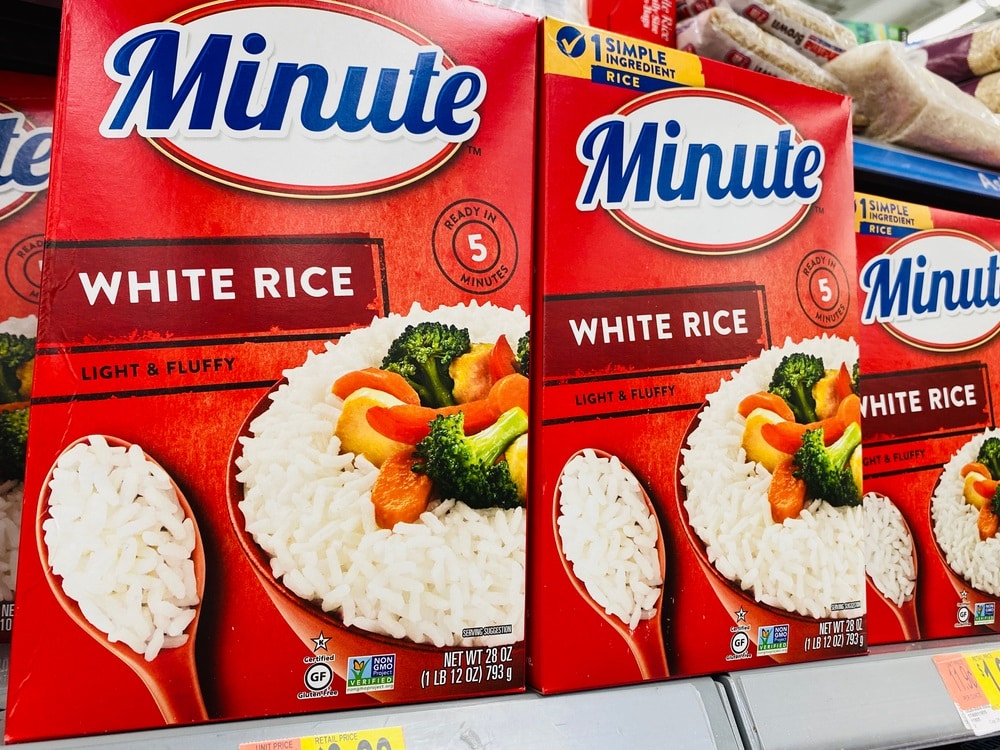

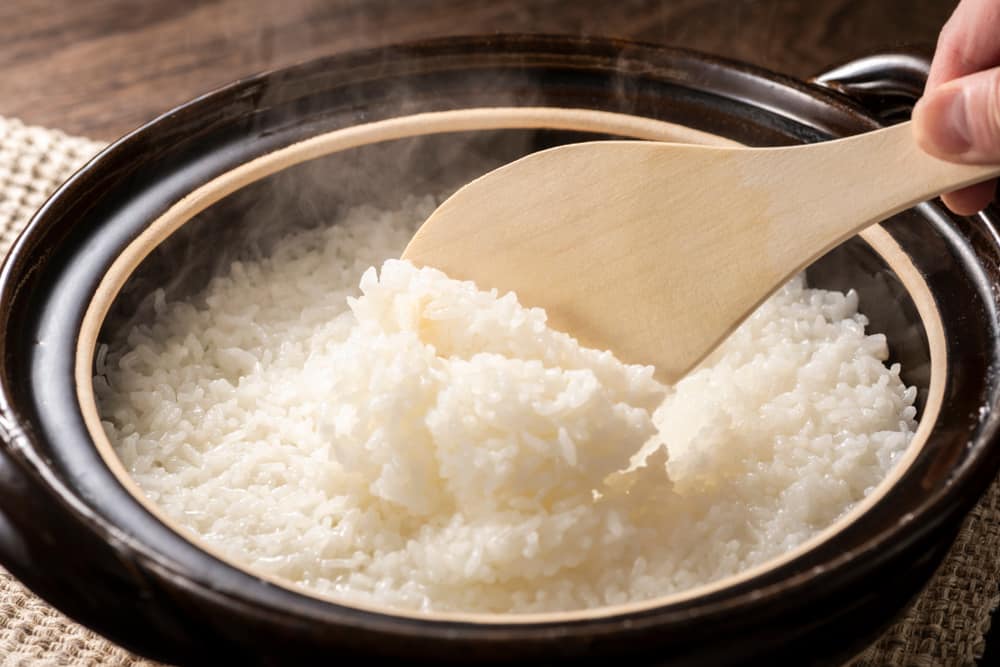
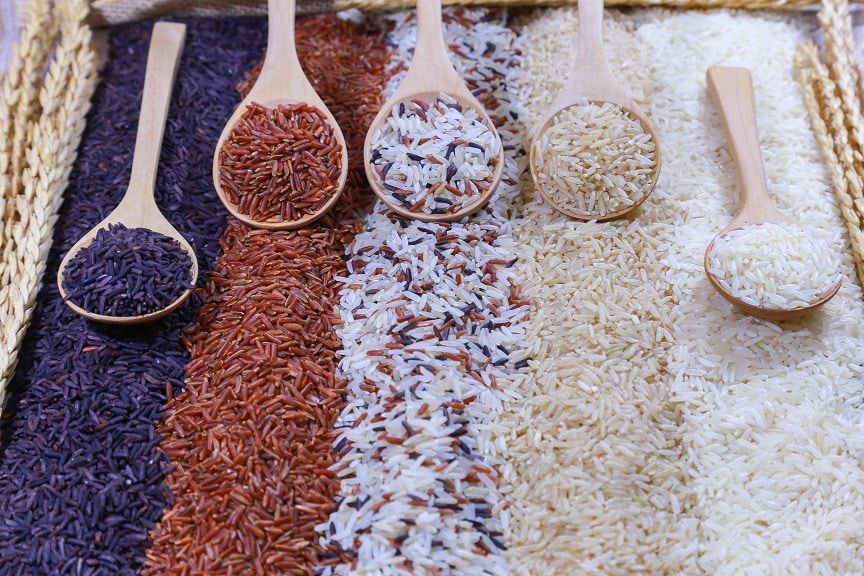

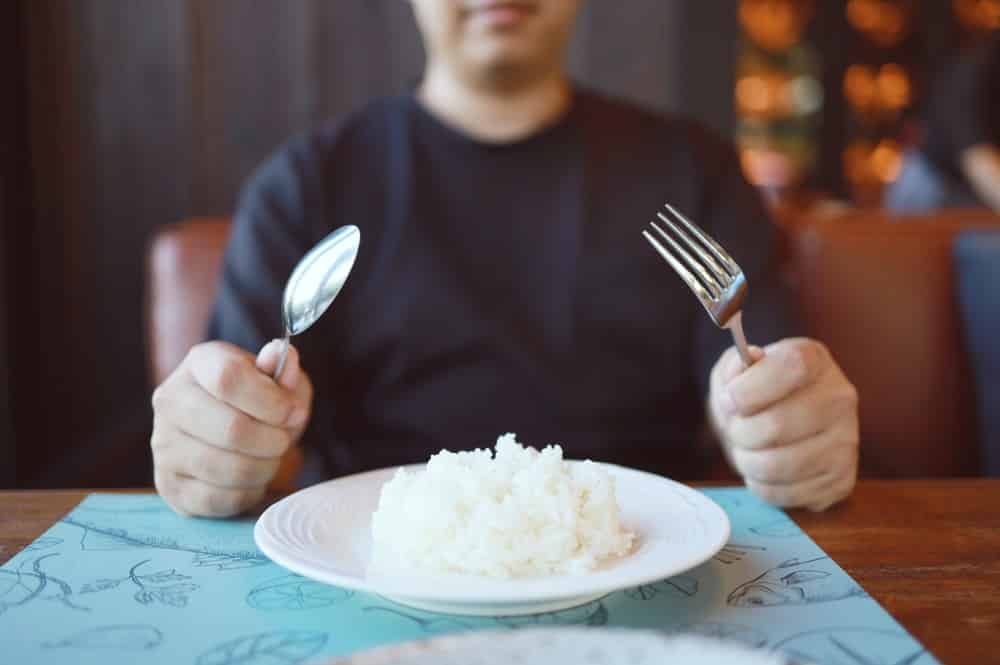
No mention of thoroughly rinsing regular rice. Some contaminants to consider are Arsenic, which is naturally existing in rice growth. This is a main concern of mine. I have used both types, love minute rice and your article states that is rinsed pre-cooking. I did not know rice needed to be rinsed pre use until a few years ago.
This is important and I hope you consider stressing rinsing natural NOT cooked rice be rinse until water is clear!